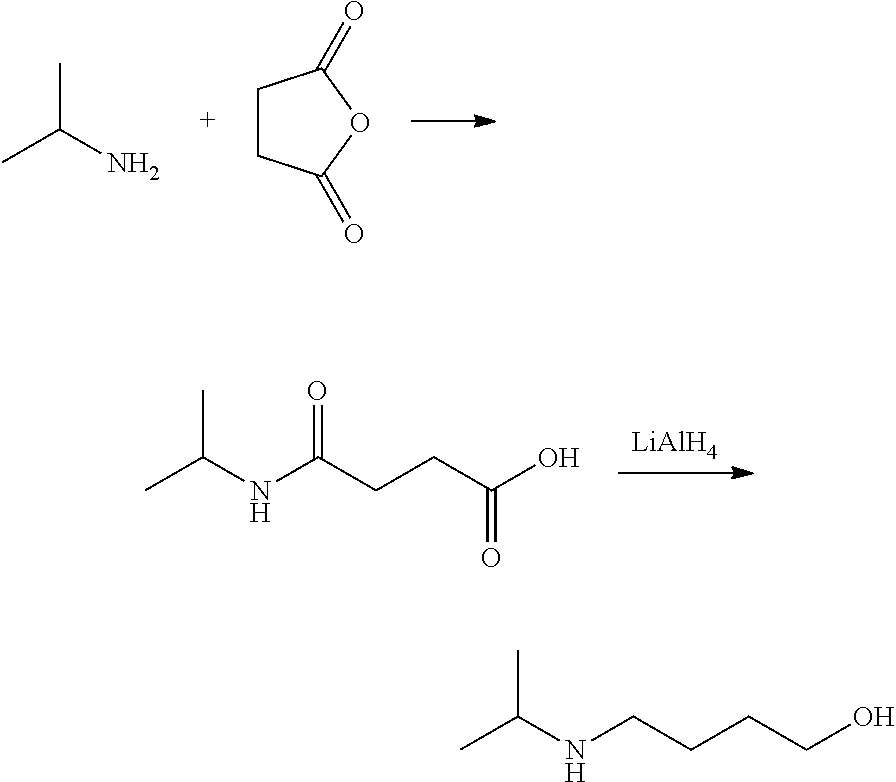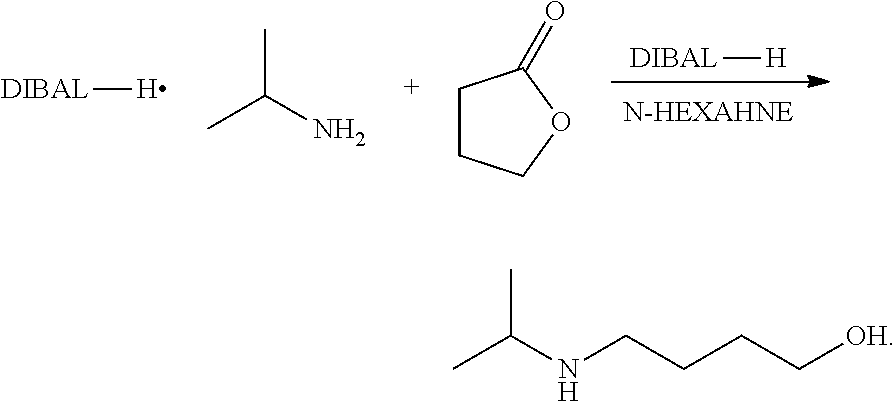Method for preparing 4-isopropylamino-1-butanol
a technology of propylamino-1-butanol and preparation method, which is applied in the preparation of carboxylic acid esters, chemistry apparatus and processes, and organic chemistry, etc., can solve the problems of high cost, low yield, and high cost of lithium aluminum hydrid
- Summary
- Abstract
- Description
- Claims
- Application Information
AI Technical Summary
Benefits of technology
Problems solved by technology
Method used
Image
Examples
example 1
Preparation of 4-bromo-1-acetoxyl butane
[0045]185 mL of tetrahydrofuran was added to a 500 mL four-neck flask and cooled to 10° C. by ice-water bath, 280 g acetic acid solution of hydrogen bromide with its mass content of 33% was added dropwise, then the mixture was heated to 25° C. and reacted at this temperature for 2 hours until the reaction was completed.
[0046]Tetrahydrofuran and acetic acid were recovered by vacuum distillation, the residue was heated to 100° C. and distilled at 2 mmHg vacuum, then 87 to 89° C. component fraction was collected to obtain 200 g of colorless clear liquid of 4-bromo-1-acetoxyl butane. The molar yield: 90%, GC purity: 99.5%.
[0047]1H-NMR data: (400 MHz, CDCl3) δ: 4.05(t, J=6.4 Hz, 2H), 3.39(t, J=6.8 Hz, 2H), 1.99(s, 3H), 1.86(m, 2H), 1.75(m, 2H).
example 2
Preparation of 4-bromo-1-acetoxyl butane
[0048]460 mL of tetrahydrofuran was added to a 1000 mL four-neck flask and cooled to 10° C. by ice-water bath, 280 g acetic acid solution of hydrogen bromide with its mass content of 33% was added dropwise, then the mixture was kept at 10° C. for 4 hours to react until the reaction was completed.
[0049]Tetrahydrofuran and acetic acid were recovered by vacuum distillation, the residue was heated to 100° C. and distilled at 2 mmHg vacuum, then 87 to 89° C. component fraction was collected to obtain 206 g of colorless clear liquid of 4-bromo-1-acetoxyl butane. The molar yield: 93%, GC purity: 99.5%.
[0050]1H-NMR data: (400 MHz, CDCl3) δ: 4.05(t, J=6.4 Hz, 2H), 3.39(t, J=6.8 Hz, 2H), 1.99(s, 3H), 1.86(m, 2H), 1.75(m, 2H).
example 3
Preparation of 4-bromo-1-acetoxyl butane
[0051]93 mL of tetrahydrofuran was added to a 1000 mL four-neck flask and cooled to 10° C. by ice-water bath, 230 g acetic acid solution of hydrogen bromide with its mass content of 40% was added dropwise, then the mixture was kept at 10° C. for 3 hours to react until the reaction was completed.
[0052]Tetrahydrofuran and acetic acid were recovered by vacuum distillation, the residue was heated to 100° C. and distilled at 2 mmHg vacuum, then 87 to 89° C. component fraction was collected to obtain 184 g of colorless clear liquid of 4-bromo-1-acetoxyl butane. The molar yield: 83%, GC purity: 99.5%.
[0053]1H-NMR data: (400 MHz, CDCl3) δ: 4.05(t, J=6.4 Hz, 2H), 3.39(t, J=6.8 Hz, 2H), 1.99(s, 3H), 1.86(m, 2H), 1.75(m, 2H).
PUM
| Property | Measurement | Unit |
|---|---|---|
| reaction temperature | aaaaa | aaaaa |
| temperature | aaaaa | aaaaa |
| temperature | aaaaa | aaaaa |
Abstract
Description
Claims
Application Information
 Login to View More
Login to View More - R&D
- Intellectual Property
- Life Sciences
- Materials
- Tech Scout
- Unparalleled Data Quality
- Higher Quality Content
- 60% Fewer Hallucinations
Browse by: Latest US Patents, China's latest patents, Technical Efficacy Thesaurus, Application Domain, Technology Topic, Popular Technical Reports.
© 2025 PatSnap. All rights reserved.Legal|Privacy policy|Modern Slavery Act Transparency Statement|Sitemap|About US| Contact US: help@patsnap.com



